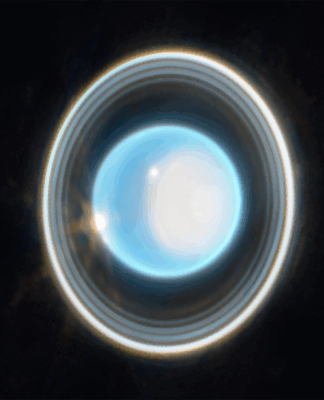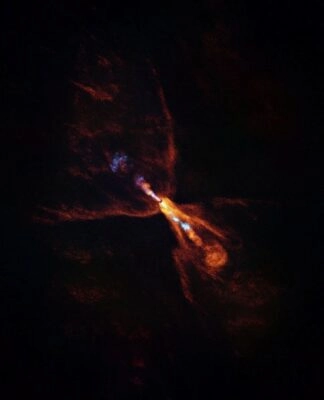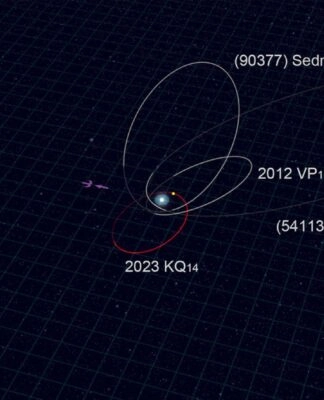Follow us on
 A team of astronomers led by the Center for Astrophysics | Harvard & Smithsonian has discovered a rare object far beyond Neptune, from a class known as trans-Neptunian objects, that is moving in rhythm with the giant planet. This image shows the orbits of all of the objects discovered in the Outer Solar System Origins Survey. The orbit of 2020 VN40 is the thickest one, tilted up and to the left from the orbits of most of the objects. The orbits of the giant planets Jupiter, Saturn, Uranus, and Neptune are the white circles. Credit: Rosemary Pike, CfA
A team of astronomers led by the Center for Astrophysics | Harvard & Smithsonian has discovered a rare object far beyond Neptune, from a class known as trans-Neptunian objects, that is moving in rhythm with the giant planet. This image shows the orbits of all of the objects discovered in the Outer Solar System Origins Survey. The orbit of 2020 VN40 is the thickest one, tilted up and to the left from the orbits of most of the objects. The orbits of the giant planets Jupiter, Saturn, Uranus, and Neptune are the white circles. Credit: Rosemary Pike, CfA
Way out past Neptune, astronomers have spotted a rare space traveler, a trans-Neptunian object named 2020 VN40. Using the LiDO survey, led by the Center for Astrophysics, Harvard \& Smithsonian, the team discovered that this icy wanderer isnt just drifting, its moving in sync with Neptune, completing one orbit around the Sun for every ten Neptune makes.
This is the first confirmed object with such a rhythm, and its helping scientists better understand how distant bodies behave in the outer reaches of our solar system. It also supports the idea that Neptunes gravity can temporarily catch these far-off objects as they pass by.
The discovery was made using the Canada-France-Hawaii Telescope, with backup observations from the Gemini Observatory and the Magellan Baade telescope, proving that teamwork across the globe can unlock secrets from the edge of our cosmic neighborhood.
The LiDO survey set out with a bold mission: to find space objects whose orbits soar far above and dip far below Earths orbital path around the Sun. These high-flying bodies belong to a little-known part of the outer solar system, a cosmic frontier thats still largely unexplored.
Dr. Samantha Lawler (University of Regina), a core member of the LiDO team, said, It has been fascinating to learn how many small bodies in the solar system exist on these very large, very tilted orbits.
2020 VN40 isnt just far, its far. On average, its about 140 times farther from the Sun than Earth, and it travels on a steeply tilted path through the solar system.
What makes it truly intriguing is how it dances with Neptune. Most objects that orbit in sync with Neptune tend to keep their distance; they swing closest to the Sun when Neptune is on the opposite side. But 2020 VN40 breaks the pattern. From a top-down view of the solar system, it looks like it comes closest to the Sun right when Neptune does, too.
But heres the twist: they only appear close. In reality, the 2020 VN40 is far below the solar systems central plane, akin to a cosmic sneak attack from the depths. No other known object with this kind of orbital rhythm behaves this way, even when you flatten the solar system into a map.
This new motion is like finding a hidden rhythm in a song we thought we knew, said Ruth Murray-Clay (University of California, Santa Cruz), co-author of the study. It could change how we think about the way distant objects move.
The discovery of 2020 VN40 shows that when orbits tilt steeply, they can create surprising and unusual patterns of motion, ones weve never seen before. And this is just the beginning.
The LiDO survey has already uncovered over 140 distant objects, and future telescopes, such as the Vera C. Rubin Observatory, promise to reveal even more cosmic oddballs. With each new find, scientists are piecing together the hidden story of our solar systems outer edge, one tilted orbit at a time.
This is just the beginning, said Kathryn Volk of the Planetary Science Institute. Were opening a new window into the solar systems past.
Journal Reference:
- Rosemary E. Pike, Ruth Murray-Clay, Kathryn Volk, Mike Alexandersen, Mark Comte, Samantha M. Lawler, Ying-Tung Chen (s�), Arcelia Hermosillo Ruiz, Cameron Semenchuck, Cameron Collyer. LiDO: Discovery of a 10:1 Resonator with a Novel Libration State. The Planetary Science Journal. DOI 10.3847/PSJ/addd22



 Cambridge University Press
Cambridge University Press



